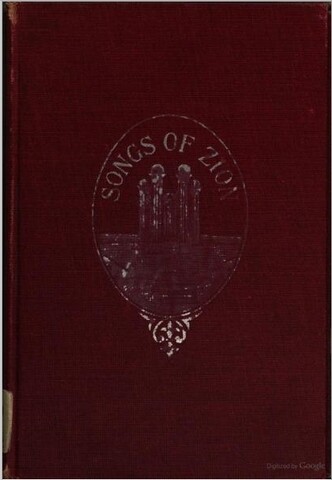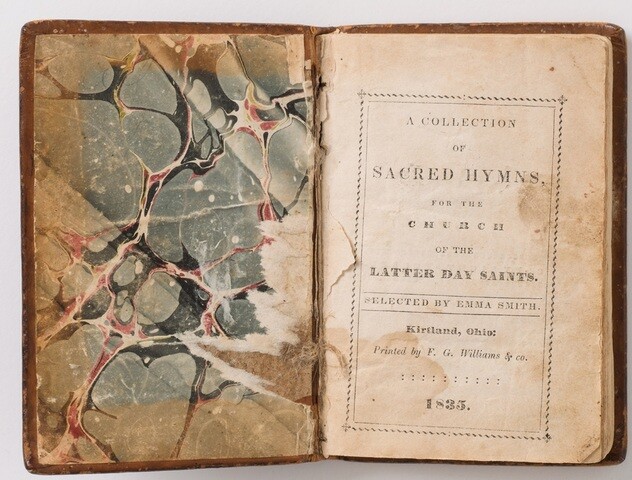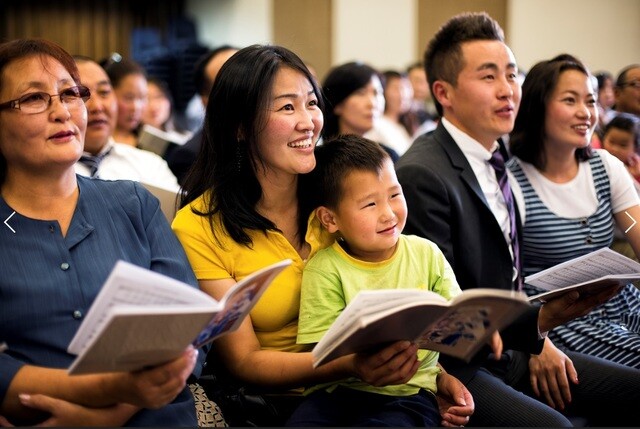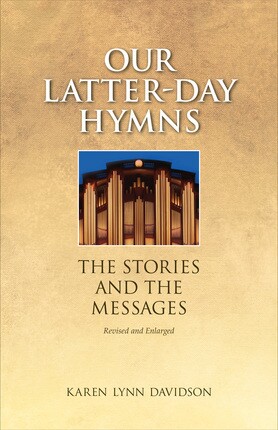The Church of Jesus Christ of Latter-day Saints announced on June 28, 2018, that it will be creating a revised Hymns andChildren’s Songbook to be used in worship services. Members from around the world can participate in the revision process by submitting hymns to newmusic.lds.org.
“We recognize the power that sacred music has to unify the members of the Church throughout the world,” said Elder Ronald A. Rasband, who will chair the hymnbook committee. “We desire to offer a consistent core collection of hymns and songs in every language that reflects the diverse needs of the global Church in our day.”
The new music collection will be created over the next several years, and this will be the 10th major LDS hymnbook used by members of the Church since Emma Smith was commanded to compile the first hymnbook in 1830. Here is a look at how the hymnbook has evolved since that time:
A Collection of Sacred Hymns for the Church of the Latter Day Saints, 1835
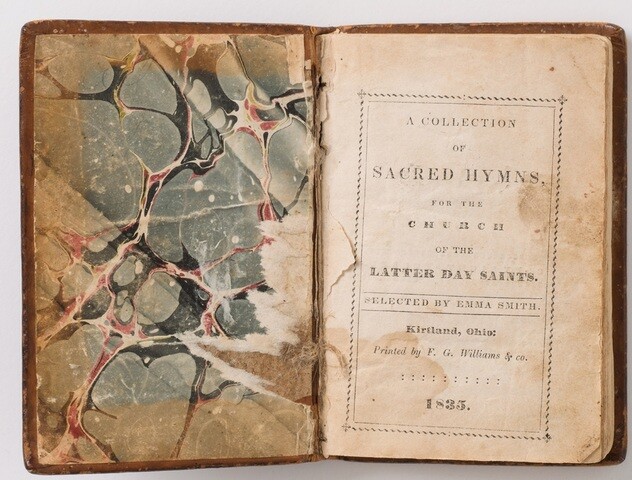
A revelation was given to the Prophet Joseph Smith in July 1830 instructing Emma Smith to begin compiling a hymnbook: “And it shall be given thee also, to make a selection of sacred hymns, as it shall be given thee, which is pleasing unto me, to be had in my church” (D&C 25:11).
The hymnbook was published five years later and was arranged and printed by William W. Phelps under the title A Collection of Sacred Hymns, for the Church of the Latter Day Saints. The hymnbook was only three inches by four-and-one-half inches, a size that can fit into a pocket. The hymnbook contained 90 hymns with only words and no tunes. Of these 90 hymns, 39 of the hymns were written by Latter-day Saints and 26 remain in today’s hymnbook, including “The Spirit of God,” “How Firm a Foundation,” and “I Know That My Redeemer Lives.”
The Manchester Hymnal, 1840
According to lds.org, the Manchester hymnal is “one of the most important hymnals of the Church.” It was published by Brigham Young, Parley P. Pratt, and John Taylor in Manchester, England, in 1840 and titled A Collection of Sacred Hymns for the Church of Jesus Christ of Latter-day Saints in Europe. During the trek westward, many new converts from overseas brought copies of the Manchester hymnal as they made the long journey to the Salt Lake Valley. It contains 271 hymn texts; at least 36 of these were written by Parley P. Pratt. The Manchester hymnal continued to be published for 72 years in 25 editions, the last of which was used in temples until 1927. It was eventually replaced by other hymnals containing music as well as text.
According to Our Latter-day Hymns, at the time, many private hymnbooks were printed for the use of members, but the Manchester hymnal held the distinction of being an official Church hymnbook.
The Psalmody, 1889
In 1886, President John Taylor called a committee to provide a musical supplement to the Manchester hymnal, which was named The Latter-day Saints’ Psalmody. It was published in Salt Lake City and was the first large collection of hymns that included musical settings with the texts, but for some of the longer texts, only the first verse was printed.
According to lds.org, “this hymnal was designed ‘to present a suitable and acceptable tune to every hymn in the Latter-day Saints’ Hymn Book.’ It included many ‘choir hymns’—such as ‘Behold the Great Redeemer Die’ and ‘As the Dew from Heaven Distilling’—created by Latter-day Saint composers for the Tabernacle Choir’s weekly performances.”
Songs of Zion, 1908

At the beginning of the 20th century, German E. Ellsworth arranged and compiled a hymnbook by surveying mission presidents to find out their favorite hymns. Songs of Zion was published by the Northern States Mission in Chicago in 1908, and it became incredibly popular and underwent 11 editions. According to lds.org, “in contrast to the choir-oriented hymns of the Psalmody, Songs of Zion included about one hundred gospel hymns, among them ‘Put Your Shoulder to the Wheel,’ ‘Dear to the Heart of the Shepherd,’ and ‘Do What Is Right.’”
Deseret Sunday School Songs, 1909
As Sunday School and Primary took on greater influence in the Church in the early 1900s, leaders of these groups felt a need to have their own music. The resulting hymnbook, Deseret Sunday School Songs, was published by the Deseret Sunday School Union, patterned after Songs of Zion, according to Mormon Newsroom. Songs of Zion includes the hymns “In Our Lovely Deseret,” “Who’s On the Lord’s Side?” and “Count Your Blessings.” This book became the most popular hymnbook in the Church at that time, according to lds.org.
Latter-day Saints Hymns, 1927
Latter-day Saints Hymns contained the best of the Manchester hymnal, the Psalmody, and Songs of Zion. The hymnbook was commonly referred to as the “green hymnbook.” According to lds.org, “it was used along with Deseret Sunday School Songs until 1948 when Hymns merged the two.” “Latter-day Saint Hymns was the first hymnbook to include the new hymns from the general membership of the Church secured through a hymn contest,” according to Mormon Newsroom.
Hymns, Church of Jesus Christ of Latter-day Saints, 1948 and Hymns, 1950

The 1948 hymnbook, which took five years to complete, contained 387 hymns and had four general classifications: congregation, choir, men’s voices, and women’s voices. Nearly half the tunes in the hymnbook were borrowed from non-LDS sources, according to lds.org. The 1948 hymnbook was intended to replace the 1927 hymnbook and Deseret Sunday School Songs. It includes many traditional hymns as well as standard Protestant hymns that had not been a part of the official Latter-day Saint hymnody, according to Our Latter-day Hymns,
In 1950, a revision was made. The 1950 hymnbook contained 341 hymns, and some of the hymns in the 1948 version were replaced with songs from earlier LDS hymnbooks
Hymns of the Church of Jesus Christ of Latter-day Saints, 1985
Hymns of the Church of Jesus Christ of Latter-day Saints is the current hymnbook used by Church members, and it was published in 1985, marking the 150th anniversary of Emma Smith’s first hymnbook. It includes 341 hymns—92 of which are new hymns and 26 of which can be found in Emma Smith’s original hymnbook in 1835. “Press Forward, Saints,” “I Believe in Christ,” and “As Sisters in Zion” were among the many songs added to the 1985 hymnbook.
As “a diverse Latter-day Saint hymnody has developed,” new hymns from later generation were added to a selection of old and borrowed hymns to create the 1985 Hymns, according to lds.org. The 1985 hymnbook was the first hymnbook translated by Church headquarters into other languages and also the first hymnbook to include scripture references for each hymn.
The Upcoming Global Hymnbook
As people from around the world join the Church, Church leaders see a greater need for diverse hymns that can represent this global church. According to Mormon Newsroom, the new hymns and children’s songbook will offer the same hymns and songs in all language. Elder Erich W. Kopischke of the Seventy said, “The language of music is universal. Even if we come from different cultures and speak different languages, singing together brings the same spirit to everybody."
Lead image from Mormon Newsroom, intext images from Wikimedia.
If you enjoy the hymns of The Church of Jesus Christ of Latter-day Saints, then you will enjoy Our Latter-day Hymns: The Stories and the Messages. In this volume, you will find the stories of all the hymns in the 1985 LDS hymnbook, so far as those stories are known. Some of the hymns came about in ways that are quite dramatic and personal; others came into being under ordinary circumstances. And each of the more than three hundred hymns has a message all its own.
Prepared with the cooperation and assistance of the General Music Committee of the Church, this companion to the hymnbook gives brief biographies of the authors and composers of the hymns, the stories of the hymns themselves, and an account of changes that may have occurred in the words or in the music.
Our Latter-day Hymns gives insight into the beliefs and history, hopes and fears of the people who sing these hymns. Church members who have music callings, as well as those who simply enjoy singing, will find this volume fascinating and informative.

